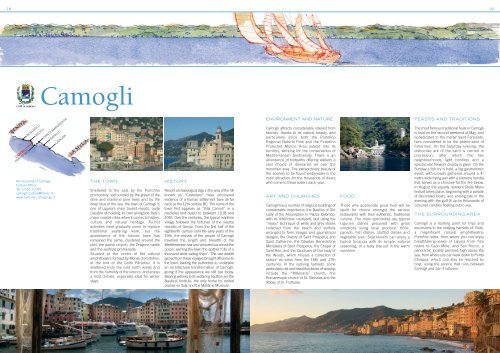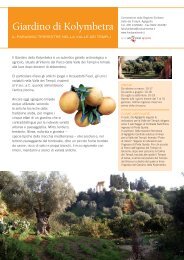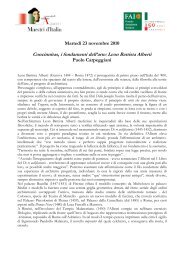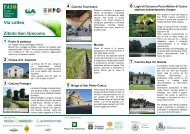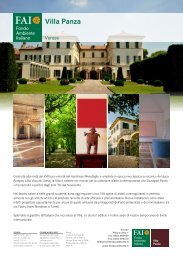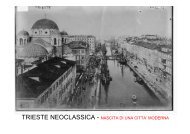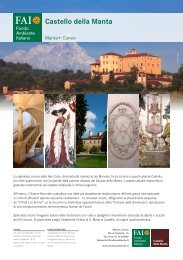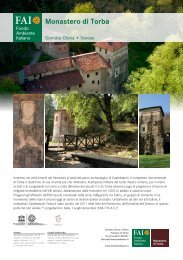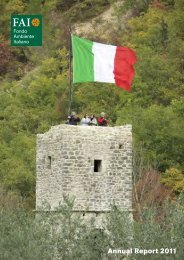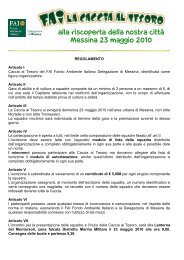You also want an ePaper? Increase the reach of your titles
YUMPU automatically turns print PDFs into web optimized ePapers that Google loves.
18 19CamogliCAMOGLIPORTOFINOMunicipality of CamogliCulture OfficeTel. 0185 72901camogli.cultura@libero.itwww.comune.camogli.ge.itBOGLIASCORECCOSANTA MARGHERITARAPALLOLAVAGNATHE TOWNSheltered to the east by the Portofinopromontory, surrounded by the green of theolive and maritime pine trees and by thedeep blue of the sea, the town of Camogli isone of <strong>Liguria</strong>'s main tourist resorts, quitecapable of holding its own alongside Italy'smajor coastal cities when it comes to history,culture and natural heritage. Touristactivities have gradually come to replacetraditional seafaring work, but theappearance of the historic town hasremained the same, clustered around theport, the parish church, the Dragone castleand the seafront promenade.Situated at the centre of the naturalamphitheatre formed by Monte di Portofino,at the end of the Golfo Paradiso, it issheltered from the cold north winds andfrom the humidity of the sirocco, and enjoysa mild climate, especially ideal for winterstays.HISTORYRecent archaeological digs in the area of the hillknown as “Castellaro” have uncoveredevidence of a human settlement here as farback as the 12th century BC. The name of thetown first appears as “Villa Camuli” in amedieval text dated to between 1018 and1045. Over the centuries, this typical maritimevillage followed the fortunes of the nearbyrepublic of Genoa. From the first half of theeighteenth century until the early years of the19th, the vessels of the people of Camoglitravelled the l<strong>eng</strong>th and breadth of theMediterranean sea and ventured out across theocean, earning the town the epithet “City of athousand white sailing ships”. The vast wealthgained from these voyages brought affluence tothe town, leading the authorities to undertakean architectural transformation of Camogli,giving it the appearance we still see today.Bearing witness to its seafaring tradition are theNautical Institute, the only home for retiredseamen in Italy, and the Maritime Museum.ENVIRONMENT AND NATURECamogli attracts considerable interest fromtourists, thanks to its natural beauty, andparticularly since both the PortofinoRegional Natural Park and the PortofinoProtected Marine Area extend into itsterritory, working for the conservation ofMediterranean biodiversity. There is anabundance of footpaths offering walkers avast choice of itineraries all over themountain area. The extraordinary beauty ofthe scenery to be found underwater is themain attraction for the thousands of diverswho come to these waters each year.ART AND CHURCHESCamogli has a number of religious buildings ofconsiderable importance: the Basilica of OurLady of the Assumption in Piazza Colombo,with its distinctive courtyard, laid using the“risseu” technique of white and grey stonescollected from the beach and skilfullyarranged to form images and geometricaldesigns; the Oratory of Saint Prosperus andSaint Catherine; the Olivetan BenedictineMonastery of Saint Prosperus; the Chapel ofSaint Ann; and the Sanctuary of Our Lady ofthe Woods, which houses a collection ofsailors' ex votos from the 16th and 17thcenturies. In the outlying hamlets, someparticularly old and beautiful places of worshipinclude the “Millenaria” church, theRomanesque church of St. Nicholas and theAbbey of St. Fruttuoso.FOODThose who appreciate good food will bespoilt for choice amongst the variousrestaurants with their authentic, traditionalcuisine. The main specialities are typical<strong>Liguria</strong>n dishes prepared with greatsimplicity using local produce: trofie,pansoti, fish dishes, stuffed dishes andvegetable pies. Snacklovers can enjoy atypical focaccia with its simple, naturalseasoning, or a tasty bite out in the warmsunshine.FEASTS AND TRADITIONSThe most famous traditional feast in Camogliis held on the second weekend of May, andis dedicated to the martyr Saint Fortunato,here considered to be the patron saint offishermen. On the Saturday evening, thedistinctive ark of the saint is carried inprocession, after which the twoneighbourhoods light bonfires and aspectacular firework display is given. On theSunday a fish-fry is held, a big gastronomicevent, with crowds gathered around a 4-metre wide frying pan with a sixmetre handlethat serves as a chimney for the fire below.In August the equally redolent Stella Marisfestival takes place, beginning with a paradeof decorated boats, and ending late in theevening with the gulf lit up by thousands ofcoloured candles floating out to sea.THE SURROUNDING AREACamogli is a starting point for trips andexcursions to the outlying hamlets of: Ruta,a magnificent natural amphitheatre;Portofino Vetta, from where you can enjoybreathtaking views of <strong>Liguria</strong> from Tinoisland to Capo Mele; and San Rocco, apanoramic locality perched high above thesea, from where you can walk down to PuntaChiappa, which can also be reached byboat, using the service that runs betweenCamogli and San Fruttuoso.


